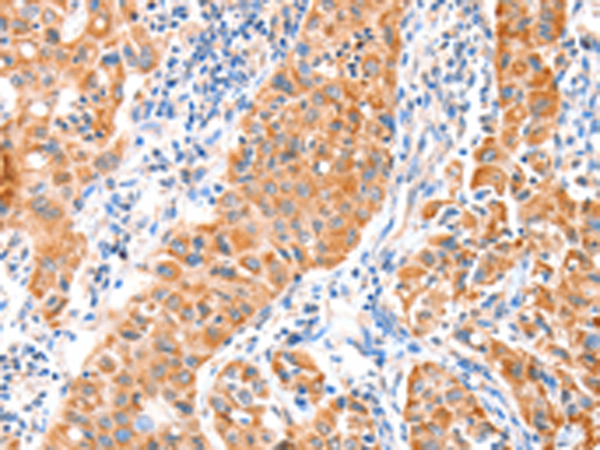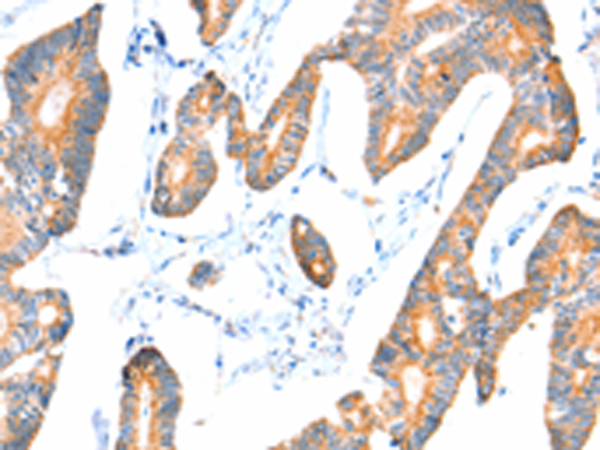


| WB | 咨询技术 | Human,Mouse,Rat |
| IF | 咨询技术 | Human,Mouse,Rat |
| IHC | 1/25-1/100 | Human,Mouse,Rat |
| ICC | 技术咨询 | Human,Mouse,Rat |
| FCM | 咨询技术 | Human,Mouse,Rat |
| Elisa | 1/1000-1/2000 | Human,Mouse,Rat |
| Aliases | LPP2; STB2; STBM2; KITENIN |
| WB Predicted band size | 60 kDa |
| Host/Isotype | Rabbit IgG |
| Antibody Type | Primary antibody |
| Storage | Store at 4°C short term. Aliquot and store at -20°C long term. Avoid freeze/thaw cycles. |
| Species Reactivity | Human, Mouse |
| Immunogen | Fusion protein of human VANGL1 |
| Formulation | Purified antibody in PBS with 0.05% sodium azide and 50% glycerol. |
+ +
以下是关于VANGL1抗体的3篇代表性文献,涵盖其在不同研究中的应用:
1. **文献名称**: *"VANGL1 mutations in human cranial neural tube defects"*
**作者**: Kibar, Z. et al.
**摘要**: 研究通过全外显子测序发现人类颅神经管缺陷患者中存在VANGL1基因突变。利用VANGL1抗体进行免疫荧光和Western blot分析,显示突变导致蛋白质稳定性降低,破坏平面细胞极性(PCP)信号通路,揭示了VANGL1在胚胎发育中的关键作用。
2. **文献名称**: *"VANGL1 regulates membrane localization of Wnt/β-catenin signaling components in colorectal cancer"*
**作者**: Lee, H.K. et al.
**摘要**: 该研究通过免疫组织化学(VANGL1抗体)和共聚焦显微镜技术,发现结直肠癌中VANGL1蛋白异常高表达,并通过与APC/β-catenin复合物相互作用促进Wnt信号通路的核转位,提出VANGL1作为潜在癌症治疗靶点。
3. **文献名称**: *"Asymmetric localization of Vangl1/2 in the zebrafish neural tube modulates convergent extension"*
**作者**: Ciruna, B. et al.
**摘要**: 利用斑马鱼胚胎模型和VANGL1特异性抗体,证明Vangl1蛋白在神经管细胞中的不对称分布对胚胎体轴延伸至关重要,并通过敲低实验证实其通过调控PCP通路协调细胞定向迁移。
4. **文献名称**: *"Antibody-based profiling of planar cell polarity proteins in developing mouse cochlea"*
**作者**: Wang, J. et al.
**摘要**: 研究使用VANGL1抗体结合免疫组织化学技术,分析小鼠耳蜗发育过程中平面细胞极性蛋白的空间分布,发现VANGL1与Frizzled6共定位于毛细胞顶部,支持其在听觉上皮极性建立中的核心作用。
这些文献展示了VANGL1抗体在基础机制研究(如信号通路、胚胎发育)及疾病模型(癌症、出生缺陷)中的关键应用,涵盖Western blot、免疫荧光、组织染色等多种实验方法。
The VANGL1 antibody is a crucial tool in studying the VANGL1 protein, encoded by the VANGL1 gene, which plays a pivotal role in the Planar Cell Polarity (PCP) pathway. This evolutionarily conserved pathway regulates tissue organization and polarized cell behaviors during embryonic development, such as neural tube closure, cochlear hair cell alignment, and directional cell migration. VANGL1. a transmembrane protein, interacts with other PCP components like Frizzled and Dishevelled to coordinate cell polarity and tissue morphogenesis. Dysregulation of VANGL1 is linked to congenital defects (e.g., neural tube defects) and diseases like cancer.
The VANGL1 antibody enables researchers to detect, localize, and quantify VANGL1 expression in cells and tissues via techniques like Western blotting, immunohistochemistry, and immunofluorescence. It is widely used to investigate VANGL1's functional mechanisms, interactions with signaling partners, and its role in developmental disorders or cancer progression. Specificity and validation (e.g., knockout controls) are critical to ensure reliable results.
Recent studies highlight VANGL1's potential as a therapeutic target or biomarker, particularly in cancers with aberrant PCP signaling. The antibody thus serves as a key reagent for unraveling VANGL1's contributions to cellular processes and disease pathogenesis.
×